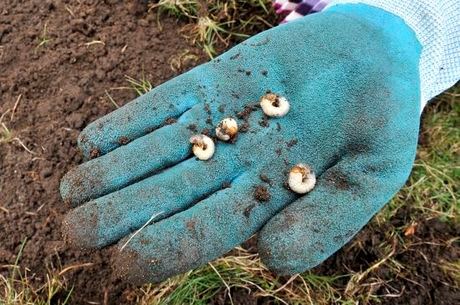From across the courtyard, the terraced greenspace at Richmond City Hall looks like any other patch of lawn.
But up close, visitors can make out tiny purple blooms among the blades – a telltale sign this is not just ordinary grass.
In fact, it’s an elegant-sounding Fleur de Lawn – an eco-friendly mix of tall fescue, micro-clover and wildflowers.
It’s pretty, practical, and best of all, it’s chafer beetle resistant – meaning it won’t get torn to shreds by crows, skunks or racoons looking for the invasive insect’s tasty grubs.
“The mix is more dynamic, it brings in more (beneficial) insects,” said Taryn Hesketh, the city’s environmental coordinator, noting that patches of grass are actually self-contained little ecosystems. “It’s more of a living lawn,” she said.
This living lawn at city hall is Richmond’s way of battling back against an infestation of chafer beetles. There is also a demonstration lawn at Garden City Park (6620 Garden City Rd.) that showcases alternative grasses/ground covers that are chafer beetle-resistant.
The half-inch beetle, originally from Europe, was first detected in New Westminster in 2001. In recent years, it migrated to Richmond, with the Terra Nova area and city boulevards being hit the hardest so far. Steveston has remained unaffected, Hesketh said, for now.
Adult chafer beetles begin to emerge in late May and continue to appear in June and throughout July. After adults lay their eggs in lawns, small larvae known as grubs emerge. They are C-shaped and light-coloured. The grubs remain near the surface of the soil, where they can devour the grass roots through the winter and into spring. Birds and small wild animals feast on these grubs, and can decimate lawns in the process.
The best way to eliminate a chafer beetle infestation is by replacing the lawn with other low-maintenance chafer-resistant greenery, such as kinnikinnick, salal, creeping thyme, ornamental grasses, Dutch white clover, a vegetable garden or perennials.
For stubborn lawn lovers, keep your turf healthy with proper care practices.
Top dress the lawn with compost and beetle-resistant blends, and lime the lawn in the fall and spring. Bare areas can be covered with netting or chicken wire to prevent further damage.
Also, reduce exterior lighting, as chafer beetles mate in the light.
One of the most effective ways to battle beetles is with nematodes (Heterohabditis bacteriophora) – microscopic worms that travel through the soil and destroy the chafer grubs from the inside out. (Insecticides are prohibited in Richmond).
The key to having success with nematodes however, is timing – they need to be added mid- to late July – and lots of water.
“Now is the perfect time to use nematodes,” said Hesketh, adding the City of Richmond has eased watering restrictions for beetle battlers.
However, a Water Use Exemption Permit is required.
In order for nematodes to survive and do their work, the application area must be well-watered two hours prior to application to eliminate dry soil in the root zone. Nematodes should be added according to package directions, preferably in the evening or on a cloudy day. The lawn must be watered again for two hours after application and then irrigated twice per week for three weeks.

To be eligible for a watering exemption, homeowners must provide proof of purchase of nematodes (showing their own receipt or an invoice from a company performing the work). A permit card must be displayed at the location and the homeowner must allow city officials to access the property to verify compliance.
Permits are available at Richmond City Hall, 6911 No. 3 Road, Monday to Friday from 8:15 a.m. to 5 p.m. They’re free for metered residents; $35 for non-metered residents.
Richmond is currently under Stage 1 water restrictions, meaning even-numbered addresses can sprinkle lawns Monday, Wednesday and Saturdays between 4 and 9 a.m., and odd-numbered addresses may sprinkle lawns Tuesday, Thursday and Sundays between 4 and 9 a.m.
All exemption permits will be cancelled if Stage 4 water restrictions are declared, when all lawn sprinkling would be prohibited.



